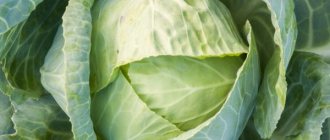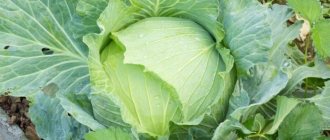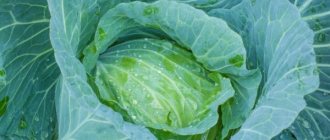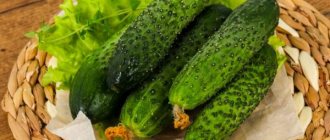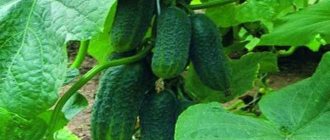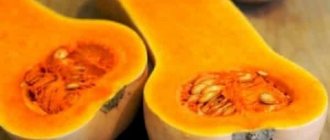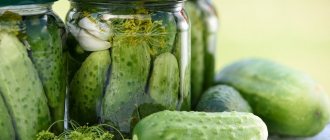Characteristics of the variety
A hybrid of white cabbage, the growing season lasts up to 120 days. The crop can be grown in open ground or in greenhouses. The heads of cabbage are compact, dense, and white in cross section. Their average weight is 4 kg.
The root system is well developed. Therefore, growing the crop is not difficult. The vegetable is consumed fresh and is suitable for fermentation.
Fact. The main feature of the variety is its resistance to diseases and pests.
Description of Cabbage Brigadier
Brigadier cabbage is one of the most common crop varieties today. Its main advantage is its hybrid characteristics. Growing the variety is possible even in cold regions of the country without the danger of pests and diseases.
Description of Cabbage Brigadier
Characteristic
White cabbage of the Brigadier variety was bred in France at the beginning of the twentieth century. The development was carried out by the Clause company.
Brigadier cabbage f1 can be grown even in the Northern regions of the country and in the Caucasus regions.
Brigadier category f1 is characterized by early maturation. The growing season lasts for 100 days from the moment the first shoots appear.
Description of the plant
The leaves are collected in a horizontal plane, forming a large head.
The leaves are large, covered with small bubbles. They are characterized by a green color with a hint of blue. The surface of the leaf of the Bogatyr category f1 is covered with a small layer of wax.
Description of the fruit
The head of cabbage is round in shape, dense. The average weight of the fetus is about 4 kg. In some cases, there are fruits weighing more than 6 kg. The inside of the head of cabbage is white.
The yield of this variety is high: up to 700 kg are harvested from 1 hectare. Fruits of this type are universal species. You can prepare both first and second courses from them. White cabbage can be stored for 3-5 months.
Features of growing crops
According to the description of the Brigadier cabbage variety, planting should be carried out only by seedlings. You should take care in advance about the correct planting of seeds.
Seed disinfection
Brigadier cabbage seeds must go through all stages of disinfection. It is recommended to use the drug "Epin". The seeds are soaked in it for 2-3 hours, after which they are thoroughly washed under cold running water.
Seeds are planted in early March in common containers. As soon as 2 pairs of main leaves appear on the seedlings, the plant is picked. It is better to use peat containers for this.
Disembarkation
Keep your distance when planting
In early April, when the seedlings reach the desired size (15-20 cm), they can be planted in open ground or a greenhouse
It is important that the soil warms up to a temperature of 14-16°C. When planting, you should adhere to the 40 x 40 cm pattern
Rules of care
Brigadier cabbage requires standard care methods
You should pay attention to watering: it is carried out once a week. As soon as the air temperature rises above 24°C, the beds are watered every 3 days
Plants should not be moistened abundantly, so as not to lead to rotting of the roots.
Basic feeding rules:
- The first feeding is carried out 10 days after planting the seedlings. It is advisable to use organic fertilizers (humus or compost). About 400 g of organic matter is added to each bush.
- The second feeding, using phosphorus, is carried out at the stage of formation of the first inflorescences. This allows the fruit to become denser.
- The third feeding, during which saltpeter is used, is carried out during the fruiting period. This allows the fruit to become heavier and increase yield.
Disease and pest control
First generation hybrid varieties are more resistant to parasites and diseases than conventional varieties. This greatly simplifies crop care. To avoid encountering parasites and diseases, preventive measures are taken.
Every 3 days, remove weeds and loosen the soil after each watering. This provides protection against root rot and flea beetles. If you spray with Oxyx solution once a week, you can protect the crop from aphids and beetles.
Advantages and disadvantages of the variety
The variety is grown everywhere and is very popular. The positive characteristics include the following:
- cabbage is not subject to cracking;
- is resistant to fusarium;
- not afraid of sudden temperature changes;
- the variety is considered one of the most stable.
If the cultivation technology is followed, there are no disadvantages.
Note. You can increase productivity if you grow the crop under film or in a greenhouse.
Predecessors of cabbage
When growing crops, special attention should be paid to crop rotation. The best precursors for cabbage are cucumbers, potatoes, onions, legumes, tomatoes, carrots, clover
It is not recommended to grow cabbage after cabbage, radishes, and turnips. Otherwise, the plants will be affected by the same diseases. Cabbage can be returned to its original place after 4 years.
Sources
- https://MoeFermerstvo.ru/kapusta/brigadir
- https://DachaMechty.ru/kapusta/brigadir.html
- https://FermoVed.ru/kapusta/brigadir-opisanie.html
- https://sveklon.ru/opisanie-kapusty-brigadir-f1
Planting seedlings
The quality of the harvest depends on the seeds. Therefore, the choice of seed material should be taken responsibly. It is best to give preference to trusted manufacturers. You can start sowing in April.
Cabbage is undemanding when it comes to soil composition. However, the soil must be prepared in the fall. To do this, you need to mix humus, turf soil, and ash.
Important. You cannot use soil from a plot where cruciferous crops were grown for planting.
First of all, you need to prepare the seeds. They need to be heated in water for 20 minutes. Then immerse in cold water. Such procedures will help protect seeds from fungal diseases. In order for the seeds to germinate, they should be treated with a growth stimulator.
You may be interested in: Favorable days for planting pepper for seedlings in 2021: terms and rules for sowing at home Favorable days for picking pepper in 2021 according to the lunar calendar Favorable days for sowing sweet and bitter pepper for seedlings in 2021
Before sowing, the soil must be moistened and the seeds sown. The depth of embedding should not be more than 1 cm. After which the container should be covered with film. For normal development, crops need to ensure a temperature within 20 degrees.
Growing seedlings
- Temperature conditions. Shoots will appear in 5 days. At this time, you need to remove the shelter and reduce the temperature to 10 degrees. As soon as the first leaves appear, the temperature can be increased to 18 degrees. In addition, plants need fresh air. However, they must be protected from drafts.
- Lighting. Seedlings need additional lighting. To do this, use a fluorescent lamp. The daylight hours of the crop should be at least 15 hours a day.
- Watering. The procedure should be given special attention. It must be timely and of high quality. Do not allow the soil to dry out or become overly moist.
- Picking. 2 weeks after emergence, it is necessary to pick. An hour before the procedure, the seedlings need to be watered well, the plants should be taken out along with the earthen ball, the roots should be shortened, and the plants should be planted in a separate container.
- Hardening. Cabbage needs to be hardened within 2 weeks. It is worth increasing your time in the fresh air every day.
Stages of feeding cabbage "Slava"
One square meter of land assumes the following composition:
- 5 grams of superphosphate;
- 4 grams of ammonium nitrate;
- 2 grams of potassium chloride.
This dry mixture is distributed between the rows, and then the cabbage is watered. The procedure must be repeated after a week.
Plants that have reached a height of 15 cm and formed 5-6 leaves are ready to appear in open ground. The bed should be watered a couple of hours before planting. For cultivation, choose a place with good sunlight, and for planting, adhere to a 60 x 60 cm pattern.
Closer to September, the bed that this cabbage variety is supposed to grow is fertilized with humus or manure. Each square meter should have 10 liters of liquid organic matter and a couple of glasses of ash. Slightly acidic soil is optimal for this variety.
As for the regions of the southern part of Russia, here the described crop can be grown without problems by direct sowing into the ground to a depth of 2 cm. For the first time, the thinning process is carried out after the appearance of the third leaf. And after three more leaves, another thinning is necessary to organize a distance of 60 cm between neighboring plants.
In terms of harvesting, the forks are ready when they reach an average size, sufficient density and no cracks. The harvested crop is stored at zero temperature and 90 percent humidity. The best storage option would be to hang forks from wooden fixtures in basements and attics. It is also possible to place cabbage in wooden boxes, where “Slava” also feels comfortable
The description of the variety also includes features of combating attacks from various parasites and defects. For ease of navigation, especially for novice gardeners, we present below the most common misfortunes to which cabbage crops are exposed and how to overcome them.
Harvesting and storage
Watering must be stopped 3 weeks before harvest. This will allow the crop to be stored for a longer period. There is no need to delay cleaning. At low temperatures, heads of cabbage lose their keeping quality.
It is worth removing cabbage from the site along with the roots. Damaged specimens cannot be stored; they must be eaten immediately.
Cabbage that is intended for storage should be placed under a canopy for a day. Then cut off its stalk and leave 3 leaves. After which the crop can be stored. The cellar is best suited for storing cabbage. There is high humidity in the room, and the air temperature does not drop below 0.
Important. To preserve the harvest, it is necessary to ventilate the room.
Methods for storing cabbage:
- tie the heads of cabbage in 2 pieces, hang them from the ceiling;
- You can store cabbage in wooden boxes;
- the heads of cabbage can be wrapped in paper, placed in a plastic bag, and placed on a shelf;
- The cabbage can be placed in a bucket of soil and sprinkled with sand.
Care
When growing, each plant requires certain rules to be followed. In order for early cabbage to feel great and give good results, it is necessary to provide it with optimal conditions.
Temperature
Air temperature is important for cabbage
When planting seedlings in a permanent place, you need to pay attention to the temperature of the air and soil. In the first case it should exceed 17˚С, in the second – 14˚С
Watering
Water temperature is at least 18˚C. It is better to moisten the soil in the morning or evening. After planting, the plants are watered every 3-4 days for 2 weeks. Often during this period the ground still has a lot of moisture. Therefore, you can cancel moisturizing. After this time, water is added once a week. Early cabbage especially needs abundant watering in June, when the heads set. 2-3 weeks before harvesting, moistening is stopped.
Loosening and hilling
It is necessary to loosen the soil after each watering or rain. Then a dry crust will not form. Plants will be able to get enough oxygen, which will strengthen their root system. A hoe is used for this purpose. When performing this action, weeds are also removed, which suppress the crop and create suitable conditions for the development of pathogenic bacteria.
You can control weeds with mulch. To do this, lay peat in a layer of 5 cm. It will also help retain moisture in the soil.
Additional nutrition will ensure hilling. Thanks to the earthen snowdrift, new roots are formed at the base of the plant. You can hill up 2 times per season. The first time the procedure is carried out together with the first application of fertilizers. The next one is in the phase of 9-10 true leaves.
Top dressing
To stimulate growth and increase green mass, Tiara F1 is fertilized. Nutrients are applied 2 times during the season:
- 10-12 days after planting the plants in a permanent place;
- while tying heads of cabbage.
Both the first and second times, organic substances can be used as fertilizing. A solution of bird droppings works well for this. It is prepared in a ratio of 1:10. Mineral fertilizers are also used. After planting, use the following solution:
- 10-15 g ammonium nitrate;
- 20-25 g of superphosphate;
- 10-15 g potassium sulfate;
- 10 liters of water.
The amount of substances is indicated per 1 sq. m. Solutions are used for root feeding. When fertilizing next time, apply to the same area:
- 8-20 g ammonium nitrate;
- 30-40 g of superphosphate;
- 15-20 g potassium sulfate;
- 10 liters of water.
Many people still use complex mineral preparations. The culture is also stimulated by spraying. The following product is prepared for processing:
- 10-12 g calcium nitrate;
- 5-8 g ammonium nitrate;
- 10 liters of water.
Reviews
Galina, 63 years old: “For several years I have been growing the Brigadir variety of cabbage. Cabbage is well stored in the cellar; fresh vegetables are on the table all winter. The whole family is happy."
Yulia, 30 years old: “We have been growing cabbage for a very long time; we paid attention to the Brigadier variety several years ago. The cultivation technology is simple, the harvest is especially pleasing. We eat vegetables with great pleasure and make canned food and preparations for the winter.”
Cabbage is the favorite crop of many summer residents. It does not require special care, and the harvest lasts all winter. The Brigadier variety is especially popular; the heads of cabbage are large, tasty, and have a marketable appearance.
Consumer properties
The Brigadier cabbage variety is a mid-late variety. The ripening period of the crop is 120-130 days from the emergence of shoots. Cabbage forms a round, almost spherical fork, covered with bluish-green, tightly adjacent leaves. The edges of the covering leaves may bend upward.
The density of the head of cabbage is one of the highest. On the scale, it is rated at 4.8 points. In cross-section, such a fork appears monolithic; when pressed by hand, the top layer does not bend. Even small-sized heads of cabbage reach an average weight of 2.5-4 kg. The largest cabbage at home can reach a weight of 5 kg.
The color of the head of cabbage when cut is snow-white, with a slight greenish tint along the edge. During processing, very little waste remains: the inner part of the stalk is short and does not even reach 1/3 of the diameter of the fork. Due to the lack of petioles, the cabbage leaves are especially tender. They are thin and tightly compressed; when chopping, no hard or large pieces remain.
The sugar content of the vegetable is lower than that of the standard Slava variety. But this has little effect on the taste of cabbage; it is characterized as sweet or sweetish. The taste is completely free of bitterness.
The main use is the consumption of fresh vegetables in the form of salads and cabbage dishes. Tender leaves without petioles are well suited for preparing cabbage rolls with meat or vegetable filling. The crispy and tender structure of cabbage allows it to be used in salads with large-cut vegetables. Shredded leaves are used to prepare hot dishes: borscht, bigos, casseroles or pancakes.
The variety is suitable for preparing winter preparations in a variety of ways. Brigadir is ideal for traditional pickling. Regardless of the size of the cut, there are no hard parts of the stalk in the mass of sauerkraut. Heads of cabbage can be fermented and cut into halves or quarters. With this method they do not fall apart and do not become soft.
In addition to pickling, Brigadir cabbage is pickled, shredded or cut into skewers, and included in winter salads and appetizers. The heads of cabbage can be saved entirely. Fresh cabbage forks can be stored until spring.
